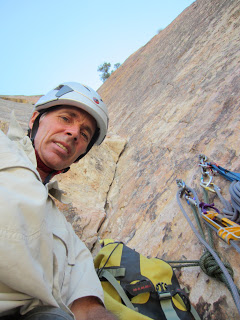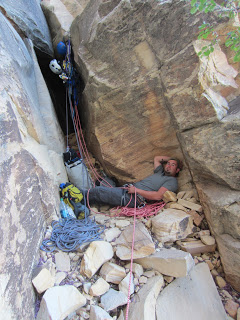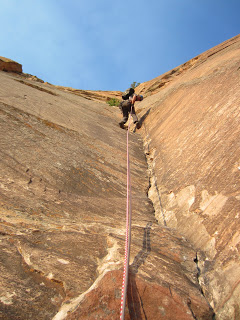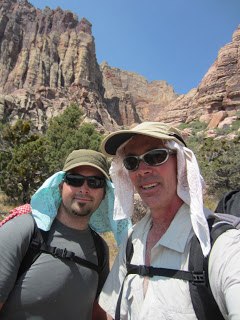This trip really began in February with lots of phone calls and e-mails to prepare for the logistics of the trip. The team even met one weekend in March in Ouray, Colorado for some ice climbing and to discuss logistics. Early June was filled with food preparations, gear checks and weighing each item to determine whether it was worth carrying on the mountain.
Finally the day arrived to travel to Anchorage, Alaska where final preparations would be made. Food and fuel was purchased and gear was exploded into the streets for the final packing. On June 16
th we drove to Talkeetna, the launching point for most attempt on Mt. McKinley, or Denali as it is known. We arrived in time for our meeting with the National Park Rangers where we were issued a Clean Mountain Can (CMC) to be our toilet for the month, and warned of all the dangers of climbing on Denali. At 4pm we were at the airstrip ready to fly onto the glacier! The flight in is worth the price of admission by itself. From the flat flood planes that surround Talkeetna the mountains begin to rise quickly. The flight takes you over “Little Switzerland” on the edge of the Alaska Range, through “One Shot Pass” and deep into the mountains to deposit you at basecamp at the foot of 14,000’ Mt. Hunter and 16,000’ Mt. Foraker.

|
| Gearing up at basecamp |
|
|
|
|
|
Once at basecamp we were anxious to get moving. Though it was late in the day, it was a good time to move through the heavily crevassed lower Kahiltna Glacier. With warm temperatures at the 7,800’ basecamp and 24 hour daylight, we quickly rigged our sleds, cached emergency food and fuel in the snow and headed down “Heartbreak Hill” to begin our journey into the night. We are all on skis, which makes crossing the massive crevasses much safer, and towing a 100 lb kiddie sled behind us laden with food and gear for the expedition. Going downhill with these beasts riding up behind you is no easy trick, but we eventually make it, turn North and begin climbing up the glacier. Even after 9 pm it was warm enough to be wearing just a t-shirt. After a couple hours a snow squall came in, reducing visibility along with the temperature. We reached the camp at 7,800’ at 2 am and quickly set up the tent and settled in for the night. We planned to sleep in the morning until it got too hot in the tent, then pack up and begin travelling late in the day after it cools and the snow bridges are stronger. In the late morning snow squalls blew in again reducing the visibility to almost nothing so we decided to continue resting until the weather improved.
After a full day of rest at 7,800’ waiting for better weather, we began slogging the 3km and 2,000 vertical up to the next camp. While this seems like a small distance to move in one day, with the amount of supplies we are hauling the pace is not exactly fast. After 6 hours of skinning in exceptionally warm temperatures we made it to camp and pitched the tent. In the evening the clouds filled in again and it began to snow quite hard. In the morning we awoke to several inches of fresh snow, and reports of more up higher on the mountain.

|
| Thanks for the great gear, Mammut! |
|
We woke early, hoping to start off before it got too hot again. It was cold in the morning, but as soon as the sun hit at 9 am it suddenly got t-shirt hot again. We set off anyway for the short but steep climb up to the 11,000’ camp. It was sweaty and hard, but we made it in about 2 hours. We moved into a nice tent site and spent the afternoon sunbathing and sorting food and gear to be cached further up the mountain. After a nice afternoon nap, we decided to take advantage of the cool evening to carry some gear up to “Windy Corner”. We loaded our packs with about 40lbs of technical climbing gear and food and set off up ”Motorcycle Hill”. This was the site of an avalanche a few days earlier which claimed the lives of 4 Japanese climbers whose bodies remain somewhere below the ice.
On our way up the clouds returned as they had each evening and it began snowing lightly. It was still warm and the visibility was good so we continued on up to 13,000’ where we dug a hole in the snow and threw in our gear. We turned around and got 2,000 vertical feet of fantastic powder skiing all the way back to the 11,000’ camp, arriving back at 11 pm. We ate a big dinner and sleep came easily after such a hard days work.
The next day we are woken up by extreme heat in the tent again, forcing us outside for coffee and another round of sorting gear into piles. We waited as long as we could for cooler temperatures, then headed off to make another cache of food and gear at the 14,200’ camp. We followed the same route up Motorcycle Hill to Squirrel Hill, around Windy Corner, which was not very windy at all and in great shape, allowing us to ski right through and even tow our sleds without too much hassle. At 14,000’ it was considerably colder in the late evening air and we all bundled up in our big puffy jackets and pants. We pitched a tent (we actually had 3 tents with us?!?) put our stuff inside, switched the skis into downhill mode and pushed off. Unfortunately the previous day’s powder had cooked in the sun and then refroze. This made for some “challenging” skiing back down to the 11,000’ camp. The clouds were well below us with some drifting up creating an amazing sunset that lasted for hours on our way back down.

|
| Leigh dropping the knee above 12,000' |
|
|
|
|
Moving day! After 3 days and 2 nights at 11,000’ we were in a good position to move up to 14,200’. We had heavy packs and one sled stuffed with food and fuel. Justin and I took turns dragging the pig up the steep hills one last time, arriving at camp just before midnight. We found an abandoned tent site with tall walls and enough room for our big tent and a cook tent, so we moved right in. Building walls of snow around your tent is time consuming (but also a good way to pass the time) and necessary for protection from wind and storms. We would spend the next couple days at 14,200’ acclimatizing, skiing and digging better and better platforms in our campsite.
Evening snowstorms kept coming in, dropping up to a foot of new snow. We took advantage of the “acclimatization days” for some creamy powder turns on the hill below the fixed lines and above the 14,200’ camp. Most people don’t use skis on Denali and I’m not too sure why. It is safer to travel over the crevasses, more fun on the days when there is nothing else to do and a much, much faster way to descend. I guess some people just don’t know what they are missing!

|
| Home sweet home at 14,000' |
|
After planning to carry a load up to the 17,000’ camp but getting
weathered out on that day, we finally got a nice day to head up. We
packed a load of food and fuel and started up the hill toward the fixed
lines. There are ropes and pickets in place on the steepest sections
from here on up the mountain. This helps to facilitate safety and
alleviate any “bottlenecking” of climbers pitching it out on their own.
We ended up being almost alone on the fixed lines with a couple parties
way ahead of us and a couple way behind. On the way up the clouds rolled
in again and it began to snow. The wind picked up toward the top and
the temperature dropped a bit. When we reach 16,000’ and the top of the
fixed lines Leigh decided she had had enough for one day, so we dug a
hole in the snow, dropped our cache inside, and headed back down the
fixed lines and the relative warmth of 14,000’. Another day of snow and
cold would follow with reports of someone being caught in a small
avalanche just below the fixed lines and another party wandering around
in the clouds unable to find the camp even though they were just a
couple hundred feet away. That night we received about 18” of fresh
making the next day a ski day!

|
| Powder skiing above 14 camp |
|
|
On the 28th
of June the weather was nice with a forecast of some good days to come.
This was to be our chance to summit. We took a leisurely morning
getting ready to go and hit the trail at noon. Leigh had decided that
the high altitude wasn’t her game and she would wait at 14,200’ camp for
our return. Justin and I made good time up the fixed lines where we
picked up our cache from the previous climb. The ridge from here to the
17,000’ camp is the longest, most technical part of the climb. While it
is not very difficult, there is exposure on both sides and a fall would
not be advisable. We took advantage of some fixed pickets along the way
to clip our rope in for protection. The steep part at “Washburn’s Thumb”
was fixed with rope making it go rather quickly. A short break after
this steep step and then we were almost there! Short of breath but
feeling strong we rolled into camp and began digging in, melting water
and settling in for the night 5 ½ hours after leaving 14 camp.
Our planned rest day at
17,000’ was more than necessary. We both woke up with classic symptoms
of Acute Mountain Sickness, headache, nausea, dizziness, and my favorite
“general malaise”. Justin faired better than I and actually got out of
the tent eventually. I spent most of the day trying to sleep and drink
water. Eventually we both began to feel a bit better and ate a good
dinner late in the evening, still hoping for a summit bid in the
morning.

|
| Climbing the ridge to 17 camp |
|
|
A little time cured everything and we woke up in the morning feeling
good and ready to go. Unfortunately the mountain had other ideas and the
forecasted calm winds and clear skies did not materialize. We delayed
our departure, worried about the moderate winds at camp and the ominous
cloud cap over the summit. After a couple hours of waiting and kicking
the snow we decided to give it a go and hope things improved by the time
we got higher on the mountain. We were traveling light for once with
just warm clothes, 2 liters of water and some food in our packs. We
stuck out toward Denali Pass with good cramponing snow and warm
temperatures. As we got closer to the pass the wind picked up and the
snow conditions turned to ice. We were happy to clip into the fixed
pickets along the way to protect us from tumbling into the large
crevasses a thousand feet below us. When we finally popped over the pass
two hours later, the wind was kicking about 30 mph and we pulled on our
warm down layers. A few hundred feet later we were out of the wind
tunnel and the temperature returned to a reasonable zero degrees
Fahrenheit. It was slow going now, with about 3 breaths needed for every
step taken as we were above 18,000’.

|
| Climbing toward Denali Pass on Summit Day |
|
|
|

|
| Feeling small on a big mountain |
Eventually we reached “The
Football Field”, a large flat area at 19,500’ and my previous high point
on the mountain. Here we took a good rest, downed some water and food
and stashed one backpack in the snow. The hill in front of us is about
40 degrees steep and only 500 vertical feet, but it takes 2 hours to
climb it. At the top of this hill we are on the knife ridge snow arête
to the summit. At this point we can look down the South side of the
mountain to the Cassin Ridge, where we had originally intended to climb.
The ridge in front of us has overhanging cornices on both sides, and
some crazy rime ice formations of the Southern side. It is a bit surreal
as airplanes are passing eye level or below and the evening sun is
hanging low on the horizon. Winds were light to moderate and the
temperature was not too far below 0 making it reasonable on the summit,
though we didn’t want to stop for long. Our video cameras froze up, and
the still cameras didn’t do much better, but we got some quick summit
photos and then turned around for the return journey. It had taken us 8
hours to reach the summit after leaving camp, and we had a long way to
get back.

|
| Happy faces on the summit! |
|
|
Back down at the Football Field we took another long rest. I think
Justin even had a nap all curled up in his down jacket. It was hard to
motivate, but I didn’t want to spend the night there, so we got out gear
back on, ate some food and headed down the hill. The sunset laid out in
front of us was beautiful and gave a sensation of warmth on the way
back to Denali Pass. We had another rest just before the pass, then
punched it around the corner and within view of camp…just 1,000 feet
higher than the tent. With each step we took down the mountain we felt
better and better as the air got thicker. As we pulled into camp, the
sun was disappearing just below the horizon or just coming back up, it’s
hard to tell when you are that far North. At midnight we crawled back
into the tent after 12 hours on the move. We brewed some water, ate some
food and slept like the dead.

|
| Sunset...or sunrise? |
|
|
Back in camp we eat and discuss our next move. We had planned on another
week before we had to leave. We intended to climb the Cassin Ridge, but
weather, conditions and conditioning took that off the table. Now we
had the choice to do some skiing on the mountain, or head for burgers
and beers at the West Rib back in Talkeetna. We got a weather forecast
that sounded like a big storm was headed our way toward the end of the
week, so it was decided we should head to basecamp sooner rather than
later. Better to get a flight out off the glacier before the storm rather than sit and wait for days on end for the weather to clear.

|
| Climbers on the fixed lines above 14 camp |
|
|
We get up relatively early and begin breaking down camp. The lower part
of the mountain is safer for travel in the evening and at night when the
snow bridges are stronger, so we have plenty of time to pack up. We
leave 14,200’ at 5 in the evening with heavy packs and towing 2 sleds.
This proves difficult going back across Windy Corner as Justin’s sled
refuses to stay upright. Eventually we stop to repack it and take the
rope off for a bit of a ski descent. We make it down by slinging the
sleds out in front and driving them like a horse buggy down the hill to
the 11,000’ camp. Here we stop to dig up some trash and leftovers that
we had cached on the way up. The hills are a bit mellower from here
down, so the skiing and sled driving gets a bit easier and we make good
time down to the 7,800’ camp. We take a long break for 4 hours here for
some dinner and to let the lower glacier freeze up some more before we
head back to basecamp. At 2 am we start back, counting the number of
holes where other teams had fallen into crevasses. Thankful for the skis
once again we glide past until the flats of the glacier at 7,000’. It’s
amazing how long it takes to climb Denali compared to how fast you can
descend on skis. Here we put skins back on and once again realized why
it is called “Heartbreak Hill”. We climbed 400 vertical feet back up to
basecamp to find that, due to the opening crevasses and melting snow,
basecamp and the airplane landing strip had been moved another mile up
the glacier. Continuing on we finally reached camp at 6 am after 13
hours of travel. We threw up the tent, not caring where, and crashed out
inside hoping to fly off the glacier in a couple hours. Unfortunately
the weather had another idea, and low clouds and snow kept the planes
from flying that day and we had to wait (sleep) until the next day
before we could fly out.

|
| All packed up and headed home |
|
|
We were lucky enough to get the first flight out on the 4
th
of July, and landed back in Talkeetna early in the afternoon. It was
shocking to be suddenly plopped in the middle of a tourist’s 4
th
of July celebration, and we took advantage of all the food and espresso
we could find. We were fortunate to get a shuttle back to Anchorage and
civilization that afternoon and suddenly found ourselves saying
good-byes and sorting gear and packing for the trip back home.
A great big “THANK YOU” to all the people at Mammut for making this
expedition happen, as well as to Justin and Leigh for all their hard
work and effort on the mountain. Though this was my third time on
Denali, it was my first time standing on the actual summit. A real big
mountain expedition experience, Denali is a true gem of a mountain and
it was great to be back in Alaska.






















